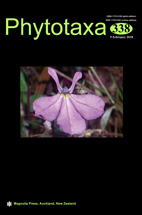Abstract
Historically, the species composition of Iris ser. Lacteae has been controversial. Morphological and molecular analyses have been conducted here including specimens covering most of their distribution range. The results suggest I. ser. Lacteae includes three species: the well-known I. lactea and I. oxypetala, plus a newly defined taxon which is endemic to the Gansu and Qinghai provinces, China. We here propose it as a new combination at the species rank, I. tibetica. Morphologically, this species is close to I. lactea but differs by its horizontal, creeping rhizome, scapes with no more than two flowers, its bracts reach the middle of the first flower, its broader inner perianth segments, its obovate with obtuse apex outer perianth segments, and its fruit apex always abruptly narrowed to a very short beak. The most useful qualitative and quantitative morphological characters used to distinguish this species are highlighted. Additionally, all three names are here typified, and a neotype for the name I. lactea and a lectotype for the name I. tibetica are designated. Notes on distribution and habitat are provided for all the accepted species.

